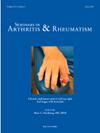Efficacy and safety of a step-down regimen of low dosage of glucocorticoids combined with early administration of synthetic or biologic immunosuppressants in anti-synthetase syndrome: A pilot study
IF 4.6
2区 医学
Q1 RHEUMATOLOGY
引用次数: 0
Abstract
Introduction
Anti-synthetase syndrome (ASS) is a rare autoimmune disease characterized by the presence of anti-aminoacyl-transfer-RNA synthetase antibodies (ARS) and the involvement of muscles, skin, joints, and lungs. Despite increasing interest and evidence, optimal clinical management remains unclear due to a lack of randomized control trials. This study aims to evaluate the efficacy and safety of a treatment regimen involving early co-administration of glucocorticoids and immunosuppressants, with rapid prednisone tapering.
Materials and methods
We prospectively enrolled patients referred to our multidisciplinary “Myositis Clinic” with a diagnosis of ASS. Clinical, serological, instrumental and medications data were collected at baseline and at 6 and 12 months follow-up. According to treatment protocol, patients were treated with traditional synthetic immunosuppressants or rituximab (RTX) depending on clinical manifestations. Prednisone (PDN) was gradually tapered and eventually discontinued within 6 or 12 months.
Results
A total of twenty-seven subjects were enrolled: arthritis, myositis and ILD were assessed in 9, 16 and 18 patients, respectively, and all of them had an active disease. RTX was administered after methotrexate (MTX) in 4 cases of refractory joint involvement and co-administration of a second immunosuppressant was necessary in 2 patients. When muscle involvement was present, first-line therapy was MTX, followed by mycophenolate mofetil (MMF) or RTX, which allowed to achieve low disease activity or remission, respectively. Eight ILD-patients were treated with MMF and switched to RTX in 5 cases of inefficacy, but all patients were in clinical remission at the end of follow-up. At 12 months, 12 patients discontinued PDN.
Conclusions
This study is the first to prospectively report on the efficacy and safety of a stepwise, steroid-sparing treatment ASS encompassing various domains. MTX, as well as other synthetic immunosuppressants, showed limited efficacy in ASS-related arthritis, while RTX emerged as a promising option. This study recommends early RTX use in case of arthritis, suggesting it as a pivotal treatment for ILD too, and raises questions regarding maintenance therapy and treatment-free remission.
低剂量糖皮质激素联合早期使用合成或生物免疫抑制剂的降级方案在抗合成酶综合征中的有效性和安全性:一项试点研究。
简介:抗合成酶综合征(ASS)是一种罕见的自身免疫性疾病:抗合成酶综合征(ASS)是一种罕见的自身免疫性疾病,其特点是存在抗氨基酸转移-RNA 合成酶抗体(ARS),并累及肌肉、皮肤、关节和肺部。尽管人们对该病的兴趣与日俱增,证据也越来越多,但由于缺乏随机对照试验,最佳临床治疗方法仍不明确。本研究旨在评估早期联合应用糖皮质激素和免疫抑制剂并快速减量泼尼松的治疗方案的有效性和安全性:我们对转诊到我们的多学科 "肌炎诊所 "并诊断为 ASS 的患者进行了前瞻性登记。我们收集了基线、6 个月和 12 个月随访时的临床、血清学、仪器和药物数据。按照治疗方案,患者根据临床表现接受传统合成免疫抑制剂或利妥昔单抗(RTX)治疗。泼尼松(PDN)逐渐减量,最终在6个月或12个月内停用:共有 27 名受试者:分别有 9、16 和 18 名患者接受了关节炎、肌炎和 ILD 评估,所有患者的病情均处于活动期。4例难治性关节受累患者在使用甲氨蝶呤(MTX)后使用了RTX,2例患者需要联合使用第二种免疫抑制剂。当出现肌肉受累时,一线疗法是MTX,然后是霉酚酸酯(MMF)或RTX,这两种疗法可分别实现低疾病活动度或缓解。8名ILD患者接受了MMF治疗,5名疗效不佳的患者转为RTX治疗,但所有患者在随访结束时均临床缓解。12个月后,12名患者停止了PDN治疗:这项研究首次前瞻性地报告了包括各个领域的逐步类固醇节省治疗 ASS 的有效性和安全性。MTX和其他合成免疫抑制剂对ASS相关关节炎的疗效有限,而RTX则是一种很有前途的选择。这项研究建议在关节炎患者中尽早使用 RTX,并将其作为治疗 ILD 的关键药物,同时还提出了有关维持治疗和无治疗缓解的问题。
本文章由计算机程序翻译,如有差异,请以英文原文为准。
求助全文
约1分钟内获得全文
求助全文
来源期刊
CiteScore
9.20
自引率
4.00%
发文量
176
审稿时长
46 days
期刊介绍:
Seminars in Arthritis and Rheumatism provides access to the highest-quality clinical, therapeutic and translational research about arthritis, rheumatology and musculoskeletal disorders that affect the joints and connective tissue. Each bimonthly issue includes articles giving you the latest diagnostic criteria, consensus statements, systematic reviews and meta-analyses as well as clinical and translational research studies. Read this journal for the latest groundbreaking research and to gain insights from scientists and clinicians on the management and treatment of musculoskeletal and autoimmune rheumatologic diseases. The journal is of interest to rheumatologists, orthopedic surgeons, internal medicine physicians, immunologists and specialists in bone and mineral metabolism.

 求助内容:
求助内容: 应助结果提醒方式:
应助结果提醒方式:


